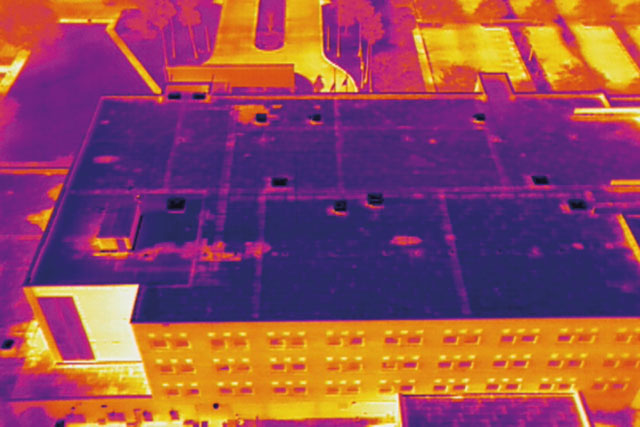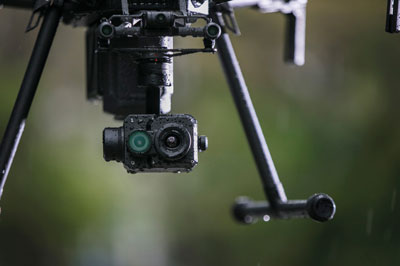Drones paired with thermal imaging cameras are highly effective for spotting hidden roof defects, says John Anderson, strategic business development manager for FLIR Systems

A new tool is making roof inspections safer, faster and more efficient by reducing the need for dangerous treks up and across rooftops. Many roof inspectors are investing in unmanned aerial vehicles (UAVs) – commonly known as drones – equipped with thermal and visual cameras so they can more easily detect moisture under roof membranes or signs of missing or damaged insulation.
Drones equipped with cameras can fly over large areas and provide a thorough view of an entire roof to establish which sections need further investigation. Traditional test methods might still be needed to quantify the extent of a problem but the overall time needed from initial scan to diagnosis is greatly reduced.

The drone bonus
Combining drones with thermal and visual cameras has several advantages over other options. Drones can be flown from a controller or execute a pre-programmed flight route. Insurance adjusters can benefit from the documentation and surety provided by this type of inspection.
The presence of water and the absence of insulation can both cause changes to the surface temperature of the roof. The thermal camera detects this temperature difference and displays it as a colour image – for example, dark tones indicate cold moisture, and light tones denote heat escaping through an uninsulated roof. As the technology does not require visible light, flights can be made during the day or night, or in shadow.
Adding a visual camera to the drone/thermal camera duo allows the capture of high-resolution roof imagery that can later be stitched together into a 3D model or ortho-mosaic. From this information, inspectors can establish whether there are any broken or missing tiles or other defects.
The operator’s experience must be considered when assessing the viability of this technology. The operator should know the variables that affect the accuracy of a thermal image and how to interpret the radiometric information. Understanding how the camera “sees” different roof materials is essential. For example, wood can absorb and emit energy, while metals will reflect it.
Camera selection
Typically drones and thermal cameras are not manufactured and designed as a single unit. Drones are made to hold several different types of camera and thermal cameras are made to be held by a variety of drones. A wide variety of drones with differing levels of sophistication can be used for roof inspection, but there are fewer thermal cameras that are right for the job.
Flir manufactures several types of thermal camera that are both compatible with a range of drones, and offer “plug-and-play” operation with systems made by drone specialist DJI Innovations. Flir’s Duo Pro R and DJI’s Zenmuse XT2 cameras both combine a thermal imager and a 4K visible light camera that are calibrated to overlap one another. This allows inspectors to get both types of imagery in a single flight and overlay these images to identify problematic areas more effectively.
Flir cameras also feature MSX (multi-spectral dynamic imaging), an imaging technology that embosses thermal photos with details from a visual image. This allows users to see words, serial numbers, patterns, and other attributes otherwise missed by thermal imaging.
Ease of use is a major consideration. A simple, flexible user interface with features to get the job done should be a selection criterion for any business thinking about adopting a new technology. In addition, potential buyers should look for a company with the infrastructure to support the products adequately over their lifetime.
Flir ready-to-fly UAS thermal imaging kits are designed for ease of use and include DJI airframes and Zenmuse XT2 cameras. By combining the flight stability, gimbal technology, and mobile app integration of DJI drones with the thermal imaging technology of Flir, the kits offer a solution for reliable, rapidly-deployable aerial thermal imaging. Flir additionally offers drone solutions for existing owners that can be configured to suit an individual pilot’s needs.
www.flir.co.uk | +44(0)1732 220011

